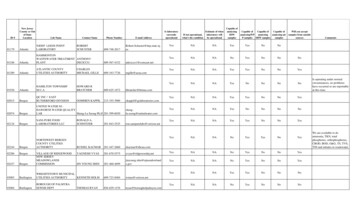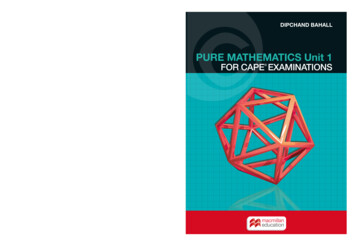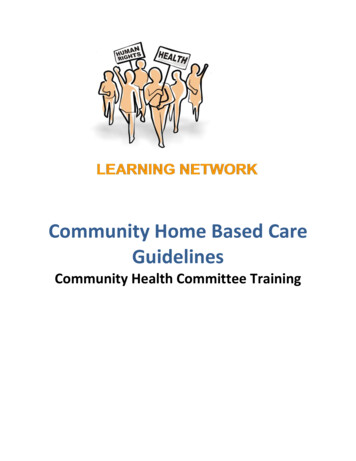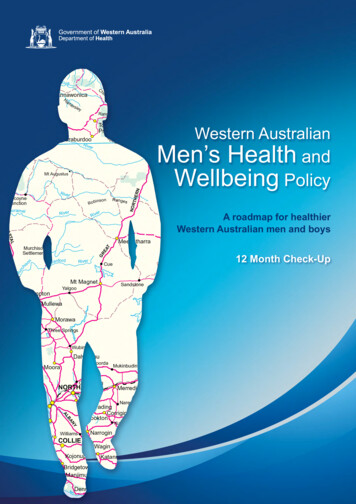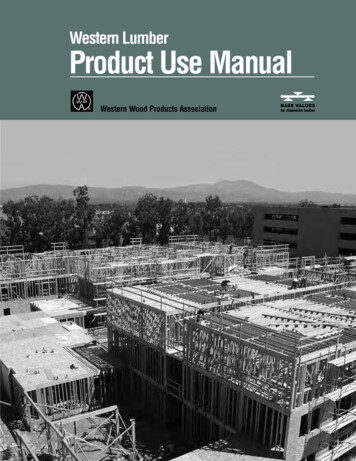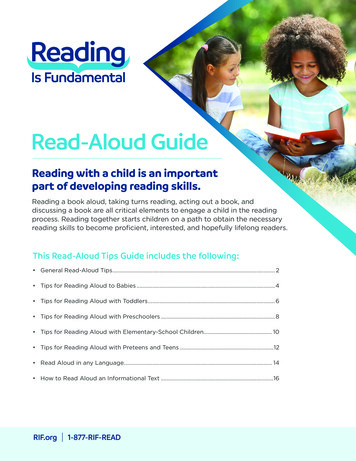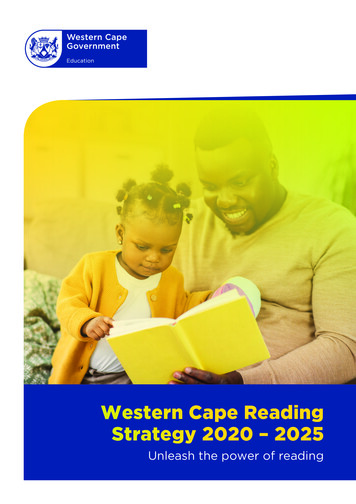
Transcription
Western Cape ReadingStrategy 2020 – 2025Unleash the power of reading
INDEX1. Foreword 21.11.2WCED Superintendent General: Mr Brian Schreuder2Deputy Director General: Dr Peter Beets 32. Introduction 53. Overview of the reading strategy 64. Pillars of the reading strategy 74.14.24.34.44.54.6Pillar 1: Learner support 8Pillar 2: Learning and Teaching Support Material10Pillar 3: Teacher professional development13Pillar 4: Research 14Pillar 5: Advocacy 16Pillar 6: Parental Involvement 175. Tips for Principals, SMTs and Departmental Heads196. eLearning: Digital Literacy 207. Visual literacy 228. Reading strategies and norms 24Western Cape Reading Strategy 2020 – 20251
1.1 FOREWORDIt gives me great pleasure to introduce toyou the Western Cape Education Department(WCED) GET Curriculum Reading Strategy forGrades R-9.The WCED vision is to ensure quality education for everychild, in every classroom, in every school in this Province.Our vision will never become a reality if we do not startat the beginning and focus on the essentials of Readingand Language proficiency at an early age.Language provides the foundation for all learning, inevery subject, so we have to ensure that all learners canread and write at levels required for their grades.Mr Brian SchreuderWCED Superintendent GeneralIf we get this right, then fewer learners will drop out ofschool and more learners will acquire the knowledgeand skills they need to make it to matric and to pursuefurther study or career opportunities.The Western Cape has a long track record of systemictesting that has informed our Language strategies,and we have invested heavily in teacher training,development and support over the years.We are continuously learning from experience andbest practice, as well as continuous engagement withspecialists in Language development.This strategy aims to further strengthen our existingLanguage and Mathematics Strategies and to supportour educators in understanding, nurturing anddeveloping learners’ language development needs.Reading is the KEY to learning2Western Cape Reading Strategy 2020 – 2025
1.2 FOREWORDToday, there is consensus that the ability toread with comprehension and pleasure is oneof the most important skills developed in theschool years, giving our learners not onlyaccess to knowledge, but the ability to usetheir acquired understanding to make senseof the world around them and take purposefulactions to create a better world.Dr Peter BeetsDeputy Director GeneralThe late Prof. Wally Morrow reminds us that “whileformal access [to schools] is important in the light of ourhistory of unjustifiable exclusions, epistemological access[that is access to knowledge] is what the game is allabout”. All future learning will depend on learners’ abilityto read with comprehension and them being able to usethat competence in the way they communicate with theworld around them.A child’s reading skills are vitally important to success in school, as those skills will allow learners toaccess the breadth of the curriculum and improve their communication and overall language skills. Inaddition, reading can be fun and can spark the imagination of children, transporting them to all kindsof new worlds.The 21st century context brings about new modes of reading that will require new reading practices.Examples of these new Modes are the use of WhatsApp and Instagram, reading the weather forecastillustrated with maps and graphs on a mobile device, and young people sharing photographs andposts with friends and followers via the Internet. These skills demand reading in new ways, astexts today are multimodal. While sounds, images, videos and words are purposefully combined toeffectively communicate with the reader in today’s “digital” world, similar sets of reading skills andstrategies as used previously, mainly for printed materials, will still have to be applied.It is against this background and the urgency to support teachers (and parents) in helping all ourlearners in the different phases of the primary school to read at the appropriate levels of fluency,accuracy, prosody and comprehension, that this guideline document on the WCED GET ReadingStrategy is welcomed. This reading strategy not only provides broad implementation directives, butit also clarifies pedagogical approaches and the needed continuity and progression clarification thatunderpin teaching reading skills from Grades R to 9.Our hope however, is that the guideline will serve as a platform to reflect on current practices andthe related successes at each school so that we can unlearn, relearn and learn to optimise the lifechances of every learner through better reading with comprehension.Reading is the KEY to learningWestern Cape Reading Strategy 2020 – 20253
2. INTRODUCTIONIn 2017 the SAQMEC and PIRLS results showed that what we have done thus far to improve reading,has not given the expected results we were looking for. We therefore realised that we need to dosomething differently. A steering committee was established to start to develop a reading strategyto address this.This Reading Strategy is the product of careful development and consultations with key interestgroups in education.The Western Cape faces various limitations and challenges in preparing young people for furtherstudy and the world of work. One of these challenges is the low level of language of our learners,which contributes to high levels of attrition and failure.Systemic research points to the fact that the language skills of the learners in the Western Cape arefar below what is required from them to learn and develop effectively.Understanding ‘how children learn’ provides the conceptual tools for teachers to deal with diverselearning contexts. The initial Language and Mathematics Strategy (LitNum) of the Western Cape hasbeen strengthened to improve learner performance, with a focus on reading.Language is vital for communicating with others in school and in the wider world, and is fundamentalto learning in all subjects. In studying languages, learners develop skills in speaking, listening, readingand writing that they will need to participate in society and employment. Learners learn to expressthemselves creatively and imaginatively and to communicate with others confidently and effectively.The purpose of the Language Development Plan is to support quality teaching and learning in alllanguages; promote additive bilingualism; support learners to have a conversational level of anAfrican language and to improve reading and reading comprehension throughout.All provincial decisions are based on the following national policies, strategies and guidelines thatinform the teaching of languages:A Language in Education Policy (LiEP)A National Curriculum Statement (NCS), including CAPS (Curriculum and Assessment PolicyStatements for each subject)A Norms and Standards for LanguagesA English Across the CurriculumA The Guidelines for Inclusive Teaching and Learning (DBE, 2010)A Guidelines for responding to learner diversity in the classroom.The plan is linked to the strategic goals of the Western Cape Education Department, visualising animprovement in literacy in all schools.Key features:A Driven by dataA Home Language and First Additional Language including English in all programmes4Western Cape Reading Strategy 2020 – 2025
A A section for each phase:-Norms-Resources/ LTSM-Methodology/ Pedagogy-Assessment-Inclusivity/ Differentiation-Teacher Professional DevelopmentA A section on the Development and growth of African LanguagesThe reading strategy is based on the WCED language strategy. Teacher professional developmentProfessional learning communitiesRecruitment, induction & retentionLearner self-esteem, learner direction &learner self-regulation Parental involvement Strategic onitoringand Evaluation Reflective practice at school levelReflective practice at district levelReflective practice at HO levelAdvocate importance of the strategyand the subject Focus on intellectual quality Language in the Mathematicsclassroom Assessment to enhance teaching andlearning A quality classroom environment Interpret policy properly[Process]Use of ProductivePedagogies[Structure]Resource / FacilityProvision and Use Acquire appropriate facilities /resources Use resources effectively Use e-learning to deepen knowledge& understandingWestern Cape Reading Strategy 2020 – 20255
66Western Cape Reading Strategy 2020 – 2025Western Cape Reading Strategy 2020 – 2025TeacherProfessionalDevelopmentMONITORING & EVALUATIONLearning andTeachingSupportMaterialsE-COMPONENTLearner supportMASS OFtheTHEREADINGSTRATEGY3. OverviewReadingStrategyParentalInvolvement
4. PILLARS OF THE READING STRATEGYThe reading strategy is built on six pillars:A Learner support through different intervention strategies;A Provision of Learning and Teaching Support Material to strengthen teaching practices;A Teacher Professional Development to ensure quality teaching;A Research to ensure that the right strategies are used;A Advocacy through different mediums to ensure mass-mobilization;A Parental/Community involvement to ensure all stakeholders are involved and fulfilling their role.All six of these pillars are underpinned with an eLearning component, monitoring and evaluation aswell as mass-mobilization.Learner supportLearning ssionalDevelopmentMONITORING & EVALUATIONResearchMASS estern Cape Reading Strategy 2020 – 20257
4.1 PILLAR 1 - LEARNER SUPPORTAll learners should receive the necessary support to ensure optimal learning.The following strategies can be employed to ensure all learners are able to learn:A Adaptation: making lessons, activities and materials suitable for different learner needs bymodifying and/or adapting itA Differentiation: lessons are planned and presented in such a way that they range from the mostbasic level to the most complex level. Activities are differentiated to accommodate learnerswith barriers to learning.A Multilevel teaching: lesson include a variety of teaching techniques aimed at reaching learnersat all levelsA Cooperative learning: learners work together to ensure that all members in the group havelearnt the same content.A The learners engage in the different stages of listening, speaking, reading and writingprocesses. Each phase gives an easy breakdown of activities for the skill to be mastered.A Learning styles: provide optional activities or different ways of doing same activity.A Pace of learning: provide for both slower and faster learners by providing optional extraactivities, additional reading or research.A Gifted learners should not be neglected and they should be extended and challenged in variousways. Giftedness takes a wide variety of forms, many of which can find expression in mostactivities.A Dyslexic learners need specialist multi-sensory tuition that is individualised to meet their needs.Never be tempted to put learners with dyslexia in groups solely based on their literacy skills.Give them time! Learners with dyslexia process information slowly.A A ‘Buddy System’ can be started so that able learners can assist hearing-impaired or visuallyimpaired learners.8Western Cape Reading Strategy 2020 – 2025
The WCED support pathway is as follows:The WCED support pathway is as follows:Western Cape Reading Strategy 2020 – 20259
4.2 PILLAR 1 - LEARNING ANDTEACHING SUPPORT MATERIALLearning and Teaching Support Material plays an integral part in successful teaching and learning.In Foundation Phase each classroom should be resourced with the following:Each learner should have:A A workbook to write inA A Graded ReaderA A dictionaryA DBE Workbook for LanguageA Access to a range of reading material to accommodate various reading levels e.g. a selection ofreaders with sufficient copies of texts at each level in a class and school.A Texts for shared reading in Grade 3. These may be books or other enlarged texts or theprescribed textbook or readers.The teacher should have:A A Curriculum and Assessment Policy StatementA Core graded readersA Dictionaries and reference books (monolingual, bilingual and multilingual dictionaries;thesaurus; encyclopaedia, a good grammar reference book, etc.)A A Teacher’s Resource File/Book: this may be a file made up of materials collected by theteacher or a commercially published Teacher’s GuideA Access to reading material in a class, school and/or public library to guide learners’ readingA Audio/visual aidsA EGRA toolkitsA PostersA FlashcardsA Alphabet cardsA Vocabulary illustrationsA GamesVideos to assist in the Early Grade Reading Assessment (EGRA) can be found at the following links:EGRA DEMONSTRATION VIDEO LINKS AND QR rs.ly/y27c3d9Resources is also available on the ePortal : https://wcedeportal.co.za10Western Cape Reading Strategy 2020 – 2025
In Intermediate Phase each classroom should be resourced with the following:Each learner should have:A An approved language textbookA Core reader/readers containing the following genre / text types:- Short Stories- Poetry- Folklore- PlaysA A dictionaryA DBE Workbook for LanguageA Access to a range of reading material to accommodate various reading levels e.g. a selection ofreaders with sufficient copies of texts at each level in a class and school.A Texts for shared reading in Grade 4. These may be books or other enlarged texts or theprescribed textbook or readers.The teacher should have:A A Curriculum and Assessment Policy StatementA Language in Education Policy (LiEP)A The language textbook used by learners and other textbooks for resource purposes in additionto the approved textA Core reader/readers containing the recommended genre / text typesA Dictionaries and reference books (monolingual, bilingual and multilingual dictionaries;thesaurus; encyclopaedia, a good grammar reference book, etc.)A A Teacher’s Resource File/Book: this may be a file made up of materials collected by theteacher or a commercially published Teacher’s GuideA Access to reading material in a class, school and/or public library to guide learners’ readingA Audio/visual aidsResources is also available on the ePortal : https://wcedeportal.co.zaIn Senior Phase each classroom should be resourced with the following:Home Language teachers should have:A a Curriculum and Assessment Policy StatementA the Language in Education PolicyA the prescribed language textbook used by learners and other textbooks for resource purposesin addition to the prescribed oneA a dictionary (monolingual, bilingual, multilingual, thesaurus)A prescribed literature genresA a variety of media materials: newspapers, magazines, brochures, flyers, etc.A access to audio/visual aids to be used in the classroomA other media resources (a variety of newspapers, magazines and brochures)Classroom resourcesA A range of texts to accommodate different reading levels, e.g. a selection of readers withsufficient copies of texts at each level for the class.A A variety of media materials: newspapers, magazines, brochures, flyers, advertisements,posters, notices, etc.A Audio/visual aidsResources is also available on the ePortal : https://wcedeportal.co.zaWestern Cape Reading Strategy 2020 – 202511
In the FET Phase each classroom should be resourced with the following:Home Language teachers should have:A the Curriculum and Assessment Policy StatementA the Language in Education PolicyA the language textbook used by learners and other textbooks for resource purposes in additionto the approved textA The following approved/prescribed literary genres:o Novelo Dramao PoetryA DictionariesA access to audio/visual aids to be used in the classroomA other media resources (a variety of newspapers, magazines and brochures)First Additional Language teachers should have:A the Curriculum and Assessment Policy StatementA the Language in Education PolicyA the language textbook used by learners and other textbooks for resource purposes in additionto the approved textA Two (2) of the following approved/prescribed literary genres:ooooNovelShort storiesDramaPoetryA Dictionaries, both monolingual and bilingual, and a thesaurusA A reference textbook for grammarA access to audio/visual aids to be used in the classroomA Media material: a variety of newspapers, magazines, brochures and flyers.A Access to reading material in a class, school and public library in order to guide learners’extensive readingSecond Additional Language teachers should have:A the Curriculum and Assessment Policy StatementA the Language in Education PolicyA the language textbook used by learners and other textbooks for resource purposes in additionto the approved textA The same choice of short stories / poems / short novel / short drama as used by the learnersA Dictionaries, both monolingual and bilingual, and a thesaurusA A reference textbook for grammarA access to audio/visual aids to be used in the classroomA Media material: a variety of newspapers, magazines, brochures and flyersA Access to reading material in a class, school and public library in order to guide learners’extensive reading12Western Cape Reading Strategy 2020 – 2025
4.3 PILLAR 3 - TEACHERPROFESSIONAL DEVELOPMENTTeacher professional development will include the following:The following strategies can be employed to ensure all learners are able to learn:A CTLI Courseso Access online at www.wcedctli.co.zaA Cluster WorkshopsoooooNeeds drivenTeaching practice and methodologyInterventionsDone at district levelLTSMA Online Courseso CeIA Professional Learning Communities (PLCs)o Small groups in same geographical areao Facilitated by Lead TeacherIn-service training for teachers should focus on specific needs such as:A how to teach reading comprehension.A computer-assisted teaching of writing.A assessing oral presentations.A helping beginner teachers set exam papers.A teaching foreign language speakers in the First Additional Language classroom.A integrated grammar teaching.A how to use textbooks properly.In-service training should form part of the broader teacher development strategy to enable teachersto grow and to avoid professional atrophy. In-service training should cater for specific target groupsof teachers per topic. Teachers should be invited to attend. A Teachers’ professional development should enable teachers to grow and to avoid professionalatrophy.A Teachers’ professional development should be informed by data, be needs-based and cater forspecific target groups of teachers per topic.A Specific topics that could be addressed include:ooooooohow to teach reading comprehensioncomputer-assisted teaching of writingassessing oral presentationshelping beginner teachers set exam papersteaching foreign language speakers in the First Additional Language classroomintegrated grammar teachinghow to use textbooks effectivelyA Teachers should be invited to attend such workshops/sessions.All Teachers’ professional development interventions will be monitored and evaluated.Western Cape Reading Strategy 2020 – 202513
4.4 PILLAR 4 - RESEARCHResearch will form an integral part of the reading strategy. All interventions will be based onthorough research. New interventions will be carefully monitored and research will be done todetermine the impact.The 2016 PIRLS results showed that:A Nationally 78% of learners cannot read for meaning by the age of 10.A Although the Western Cape performed the best, the data shows that 55% of learners cannotread for meaning by the age of 10.The 2019 systemic tests shows that only 53% of Grade 3 learners could pass the component ofReading and Viewing.Lang Provincial Pass % Results 2011 - 2019Gr3 Pass %Gr6 Pass %Gr9 Pass %Gr3 Ave %Gr6 Ave %Gr9 Ave 9 Diff 19/18 Diff 19/1144.9-0.914.542.84.311.353.61.09.4Lang Provincial Results 2011 - .3Western Cape Reading Strategy 2020 – .3201845.444.051.12019 Diff 19/18 Diff 19/1144.2-1.25.545.61.64.751.90.83.0
GRADE 3 LANGUAGE RESULTS 2013 - 2019AREAS TESTEDAREASTESTEDReadingand ViewingAREASAREAS TESTEDTESTEDWritingReadingandViewingThinking& ReasoningReadingReading andand ViewingViewingWritingLanguageStructureand g&Thinking& ReasoningReasoning UseLanguageLanguage StructureStructure andand No. ofLearnersNo.2019ofNo.No. ofofLearners95 452LearnersLearners20199545220192019954529595 452452954529595 452452954529595 4524529595 452452954529595 45245295452Pass %GRADEGRADE 33 LANGUAGELANGUAGE RESULTSRESULTS 20132013 -- 20192019Pass 17Pass%43.4 46.7201648.2 201756.320162016 2017201743.446.746.350.743.443.4 46.746.748.256.327.629.848.248.2 56.356.346.350.742.546.646.346.3 50.750.727.627.6 29.829.827.629.842.442.4 42.542.5 46.646.642.442.546.6Pass 036.962.736.936.944.962.762.762.744.944.944.9Diff 19/183.6Diff19/18-0.5DiffDiff 742.7AverageAverage%20162017 %2018Average%46.2 47.6 48.0201640.4 201745.3 201833.520162016 20172017 2018201846.247.648.046.548.444.946.247.646.2 47.6 48.048.040.445.333.529.731.431.040.440.4 45.345.3 33.533.546.548.444.945.547.345.446.546.5 48.448.4 44.944.929.731.429.7 31.431.4 31.031.029.731.045.045.0 45.545.5 47.347.3 45.445.445.045.547.345.4Average 4.544.243.043.043.044.244.244.2Diff 19/181.2Diff19/181.0DiffDiff .2-1.2-1.2Average20162017 %2018AverageAverage %%46.3 46.0 46.0201619.4 201715.6 201835.020162016 20172017 2018201846.346.046.044.443.837.846.346.3 46.046.0 46.046.019.415.635.019.419.4 15.615.6 35.035.037.844.443.844.4 43.843.8 44.037.844.437.835.035.035.044.443.844.4 43.843.8 44.044.044.444.0Average 5.6Diff 19/183.3Diff19/183.2DiffDiff .6Average20162017 %2018Average%Average%72.5 72.9 73.7201634.9 201732.2 .072.5 72.972.9 43.973.772.573.734.9 32.232.2 33.133.155.552.861.134.934.9 32.2 33.145.552.6 42.051.3 43.951.145.542.045.5 42.0 43.943.955.552.861.155.552.855.5 52.8 61.161.152.651.351.152.652.6 51.351.3 51.151.12019 Diff 19/1854.7 -19.0201919/1848.7 Diff2019Diff15.619/182019 Diff19/1854.7-19.054.7-19.054.7 -19.048.715.633.6-27.548.748.7 15.615.651.90.833.6-27.533.6-27.533.6 45.246.745.245.244.244.244.246.745.046.746.7GRADE 6 LANGUAGE RESULTS 2013 - 2019No. ofLearners% 2018 2019 Diff 19/18 2013No.20172019of 2013 2014 2015 2016PassPassNo.Pass %%No. 7.936.844.143.041.9 50.38.439.3AREASLearnersAREAS 01.816.0201320192013 20142014 20152015 20162016 20172017 20182018 20192019 DiffDiff 19/1819/18 138.730.338.7Reading898.439.3Reading andand ViewingViewing89 834834 29.529.5 37.937.9 36.836.8 44.144.1 43.043.0 41.941.9 922.218.031.233.01.816.0Writing89 834 19.3 30.922.2 18.0 31.2 ing andand reasoningreasoning89 834834 27.227.2 35.335.3 36.836.8 40.140.1 38.738.7 983431.2LanguageStructureandUse89 83483431.2Language Structure and Use8931.2PROVINCE894.339.3PROVINCE89 834834 29.529.5 37.937.9 36.836.8 40.140.1 38.738.7 38.538.5 .542.84.339.3Pass %No. ofAREAS TESTEDLearners%No.20172019of 2013 2014 2015 2016PassPass% 2018 2019 Diff 19/18 2013No.Pass%No. 0.288.689.791.590.9 60.5 -30.4 65.0AREAS .1 201951.2 Diff36.62013 20142014 20152015 20162016 20172017 201820182019Diff26.119/18 Reasoning7055132.126.533.839.330.940.5Reading andand ViewingViewing70 551551 81.081.0 80.280.2 88.688.6 89.789.7 91.591.5 90.990.9 60.560.5 -30.4-30.4 38.965.0Reading7065.0Writing Structure and Use27.1 42.222.6 51.023.1 53.426.0 49.821.4 61.125.1 28.751.2 -32.426.136.6Language70 551551 6.6Writing70 551 27.1 22.6 23.1 26.0 21.4 25.1 144.142.251.053.449.861.128.7-32.4Language Structure and Use70 551 44.1 42.2 51.0 53.4 49.8 61.1 28.7 -32.4 .050.9SAunderperformed inPROVINCE7055147.653.052.61.050.9PROVINCE70 reading551 47.847.8 compared47.6 53.053.0 55.155.1 to53.0SAQMEC52.6 53.653.6 average.1.050.9AREAS erage %GRADEGRADE 66 LANGUAGELANGUAGE RESULTSRESULTS 20132013 -- 43.443.443.443.443.443.243.2 43.443.4GRADE 9 LANGUAGE RESULTS 2013 - 201943.243.4GRADEGRADE 99 LANGUAGELANGUAGE RESULTSRESULTS 20132013 -- SAunderperformedin readingcomparedSAQMEC andaverage. The % of learnersthat performedat tointerpretiveinferential readingSASA underperformedunderperformed inin readingreading comparedcompared toto SAQMECSAQMEC average.average.levels improved,but performanceat the analyticalSA underperformedin readingcompared to SAQMECaverage. and critical reading ntial dreading% learnersof learnersthatperformedat interpretiveand .A readingreadinglevels improved, criticallevels improved,improved, butbut performanceperformance atat thethe analyticalanalytical andand criticalcritical levelsURGENTattention. The% requireof learnersachievingat the higher SACMEQ levels of readinglevelslevels requirerequire URGENTURGENT attention.attention.A Thecompetence% of learners achievingat the higherwas significantlylow. SACMEQ levels of reading competence was significantlyThe%oflearnersachievingatthehigher SACMEQlevels ofreadingThe%oflearnersachievingatthelow. The % of learners achieving at the higherhigher SACMEQSACMEQ levelslevels ofof readingreadingcompetence waswas significantly low.low.competencecompetence was significantlysignificantly low.Western Cape Reading Strategy 2020 – 202515
4.5 PILLAR 5 - ADVOCACYA successful language programme requires an effective principal, as a curriculum leader andmanager. Every aspect of the above language plan must be addressed by the principal and theschool management team.This includes:A Demonstrating respect for the unique characteristics and needs of the phase and the learners,teachers and parents.A Recognising, understanding and taking remedial actions for the specific language challengesfaced in the FP.A Regularly reviewing the school language policy, in consultation with stakeholders, in the bestinterests of the learners and community.A Celebrating World Book Day which is an internationally recognised event that celebratesbooks and a love of reading, and emphasizes the importance of reading for life-long learning,cognitive development and psychological well-being.A Schools are requested to organise reading activities for all grades leading to InternationalLiteracy Day.To strengthen reading and to get all stakeholders on board it is important that advocacy should bedone to schools, parents and learners. This will be done through various platforms:A Live StreamingA Social MediaA Pamphlet on reading16Western Cape Reading Strategy 2020 – 202516A EmailsWestern Cape Reading Strategy 2020 – 2025A Radio
17Western Cape Reading Strategy 2020 – 2025Parentaloutmostimportance.The schooland parentshouldform a partnershipensurethat canthe developlearner can developParental involvementinvolvement isisofofoutmostimportance.The schooland parentshould forma partnershipto ensure tothatthe learneroptimally.Tips forfor parentsparentswillwillin
3.Overview of the reading strategy 6 4.Pillars of the reading strategy 7 4.1Pillar 1: Learner support 8 4.2 Pillar 2: Learning and Teaching . Learner self-esteem, learner direction & learner self-regulation Parental involvement Strategic partnerships Focus on intellectual quality Language in the Mathematics
